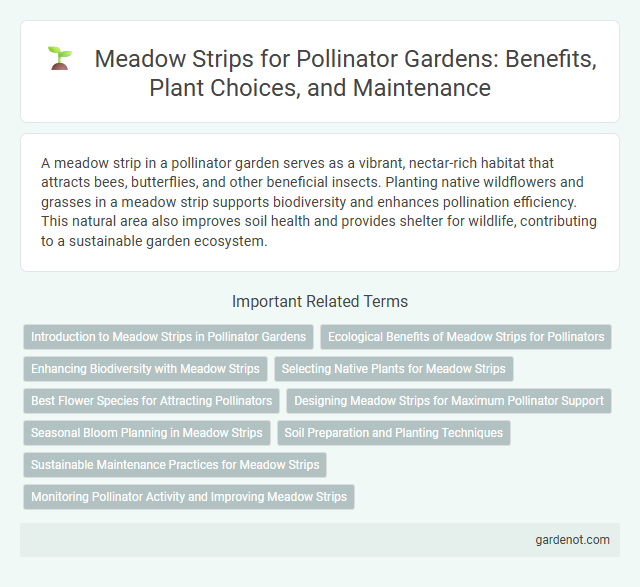A meadow strip in a pollinator garden serves as a vibrant, nectar-rich habitat that attracts bees, butterflies, and other beneficial insects. Planting native wildflowers and grasses in a meadow strip supports biodiversity and enhances pollination efficiency. This natural area also improves soil health and provides shelter for wildlife, contributing to a sustainable garden ecosystem.
Introduction to Meadow Strips in Pollinator Gardens
Meadow strips in pollinator gardens provide essential habitats by offering a rich diversity of native wildflowers and grasses that support bees, butterflies, and other pollinators. These strips enhance biodiversity and improve ecosystem services such as pollination and soil health. Incorporating meadow strips into garden design promotes sustainable environments and supports declining pollinator populations.
Ecological Benefits of Meadow Strips for Pollinators
Meadow strips provide essential habitats that increase biodiversity by offering diverse floral resources and shelter for pollinators such as bees, butterflies, and hoverflies. These habitats enhance pollinator foraging efficiency and support life cycles by supplying continuous nectar and pollen throughout the growing season. Implementing meadow strips can improve ecosystem resilience, promote natural pest control, and contribute to sustainable agricultural practices.
Enhancing Biodiversity with Meadow Strips
Meadow strips planted with diverse native wildflowers and grasses create essential habitats for pollinators such as bees, butterflies, and hoverflies, significantly boosting local biodiversity. These strips improve ecosystem services by supporting a variety of pollinator species year-round, increasing plant pollination success and enhancing overall garden health. Strategic placement of meadow strips along garden edges or pathways maximizes connectivity, enabling pollinators to thrive and contribute to sustainable, resilient urban green spaces.
Selecting Native Plants for Meadow Strips
Selecting native plants for meadow strips enhances local biodiversity by providing essential habitats and food sources for pollinators such as bees, butterflies, and hummingbirds. Native species like Echinacea purpurea, Asclepias tuberosa, and Solidago canadensis thrive in regional soil and climate conditions, ensuring sustainable growth and minimal maintenance. Incorporating a diverse mix of flowering plants that bloom at different times supports pollinator populations throughout the growing season.
Best Flower Species for Attracting Pollinators
Native wildflowers like Black-eyed Susan, Purple Coneflower, and Butterfly Weed thrive in meadow strips, providing vital nectar and pollen sources for bees, butterflies, and hummingbirds. Milkweed species support monarch butterflies by serving as essential larval host plants, enhancing biodiversity and pollinator health. Incorporating a diverse mix of bloom times ensures continuous food availability from early spring through late fall, maximizing pollinator attraction and garden productivity.
Designing Meadow Strips for Maximum Pollinator Support
Designing meadow strips for maximum pollinator support involves selecting native flowering plants with staggered bloom times to provide continuous nectar and pollen sources throughout the growing season. Incorporating diverse plant species such as milkweed, coneflowers, and goldenrod enhances habitat complexity, attracting a variety of pollinators including bees, butterflies, and hoverflies. Proper soil preparation, avoiding pesticide use, and maintaining varied plant heights promote nesting sites and shelter, crucial for sustaining healthy pollinator populations.
Seasonal Bloom Planning in Meadow Strips
Seasonal bloom planning in meadow strips enhances pollinator habitats by ensuring continuous availability of nectar and pollen sources from early spring to late autumn. Incorporating native wildflowers with staggered flowering times, such as coneflowers, black-eyed Susans, and asters, supports diverse pollinator species including bees, butterflies, and hummingbirds throughout the growing season. Strategic seed selection and planting schedules optimize meadow strip productivity and promote ecosystem resilience in pollinator gardens.
Soil Preparation and Planting Techniques
Proper soil preparation for a meadow strip in a pollinator garden involves loosening the soil to a depth of 6 to 8 inches and removing existing vegetation to reduce competition. Selecting native wildflowers and grasses suited to the local climate ensures resilient plant growth and optimal bloom succession. Planting techniques such as seed broadcasting followed by gentle raking help achieve uniform coverage, while mulching prevents weed invasion and retains soil moisture.
Sustainable Maintenance Practices for Meadow Strips
Sustainable maintenance practices for meadow strips emphasize minimal disturbance techniques such as selective mowing and seasonal cutting to promote native wildflower growth and enhance pollinator habitats. Incorporating organic soil amendments and avoiding chemical pesticides supports soil health and biodiversity, fostering resilient ecosystems. Regular monitoring of plant species diversity ensures adaptive management, optimizing conditions for bees, butterflies, and other vital pollinators.
Monitoring Pollinator Activity and Improving Meadow Strips
Monitoring pollinator activity in meadow strips involves systematic observation of bee, butterfly, and other pollinator visitation rates to identify species diversity and peak foraging times. Using data collected from periodic surveys, land managers can adjust planting schemes by introducing native wildflowers that bloom sequentially to provide continuous food resources. Improving meadow strips with habitat enhancements such as nesting sites and reducing pesticide exposure significantly boosts pollinator health and ecosystem resilience.
Meadow strip Infographic

 gardenot.com
gardenot.com